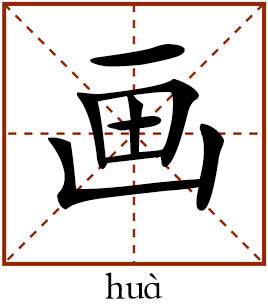Painting

When used as a noun, this character refers to a painting or picture. When used as a verb, it means “to paint, draw or sign.”
画龙点睛
huà lóng diǎn jīng
Hua means “to draw” and long refers to a dragon. Dian means “to dot” and jing refers to eyes. It indicates that adding just a touch brings a work of art to life.
The Chinese idiom “Paint the dragon, dot the eyes” derives from Lidai Minghua Ji (Famous Paintings through History). During the Southern and Northern Dynasties Period (420–589), a painter named Zhang Sengyao was known for his incredible lifelike paintings. One day Zhang painted four dragons on a wall of Anle Temple in Jinling (present-day Nanjing, Jiangsu Province). By the time he finished, the audience, moved by his prowess, noticed that the dragons’ eyes were missing. Zhang did it on purpose. He said that the eyes were the spirit of the dragon. “If the eyes are added, the dragon would come to life and fly away.” No one believed Zhang and they insisted that the dragon should have eyes. Finally, Zhang dotted the eyes of two of the dragons. As a bolt of lightning struck the wall where the dragons were painted, two dragons came to life and flew away. The other two “blind” dragons remained as paintings on the wall. This idiom means to add a vital finishing touch to turn something already good into perfection.
诗中有画
shī zhōng yǒu huà
Shi refers to a poem and hua a painting. This term means that a poem holds a painting within it.
This term originates from the writings by the great Song poet Su Shi. “When reading Wang Wei’s poems, one can conjure up a picturesque image. When viewing Wang Wei’s paintings, one can experience a poetic sentiment.” Wang Wei was one of the most famous literati of arts and letters during the Tang Dynasty. This expression highlights the connection between poetry and painting in their ability to create aesthetic imagery. Painting creates an aesthetic effect through images presented. Poetry, on the other hand, is a language art, which creates an aesthetic effect through the use of words. This idea of Su Shi’s had a far-reaching influence on the subsequent development of literature and painting in China.
edited by REN GUANHONG

 PRINT
PRINT CLOSE
CLOSE